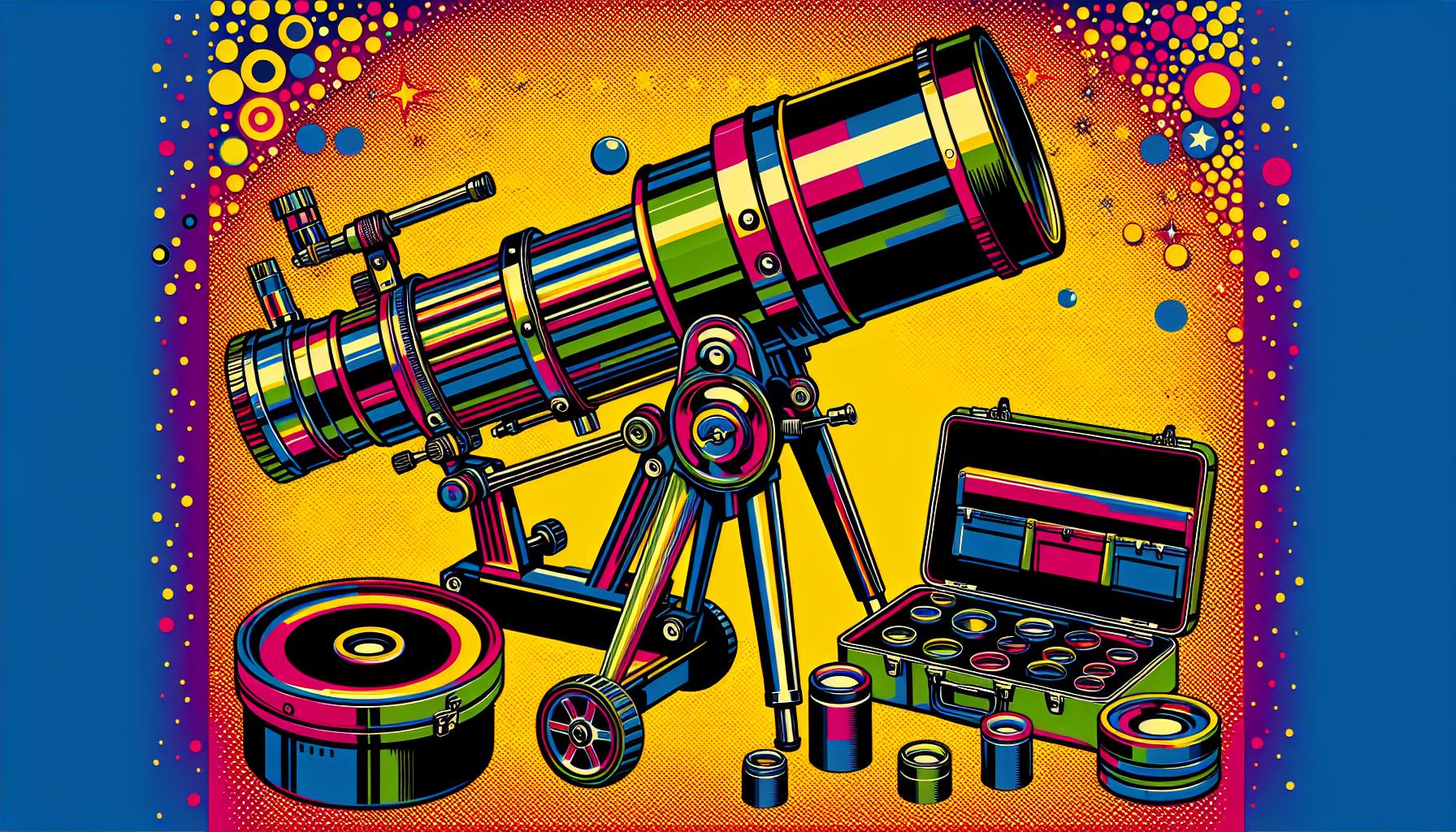This site contains affiliate links to products. I may receive a commission for purchases made through these links.
Stargazing is a hobby that’s fascinated me for years. One question I often get from fellow enthusiasts is, “Are Dobsonian telescopes portable?” It’s a valid question, considering the size and weight of these powerful tools.
Dobsonian telescopes, named after their inventor John Dobson, are known for their large aperture and ease of use. They’re the go-to choice for many amateur astronomers. But when it comes to portability, there’s a bit more to consider.
In this article, we’ll dive into the nitty-gritty of Dobsonian telescope portability. We’ll examine factors like size, weight, and design that can influence how easy it is to pack up your telescope and head out for a night under the stars. So, if you’re pondering whether to invest in a Dobsonian telescope, stick around – this article’s for you.
Size of Dobsonian Telescopes
When examining the portability of Dobsonian telescopes, it’s impossible to ignore the elephant in the room – their size. For starters, Dobsonian telescopes are not small. These tools, beloved by many amateur astronomers, are lauded for their large aperture. It’s the aperture that permits light to enter the telescope, enabling stargazers to view distant celestial bodies with greater clarity and detail.
Dobsonian telescopes come in a range of sizes. The size of the telescope is determined primarily by the diameter of the primary mirror, which can range from a manageable 6 inches to an imposing 30 inches. The primary mirror’s size directly impacts the telescope’s overall dimensions and weight. So, a telescope with a larger primary mirror will naturally be bulkier and heavier.
Here’s a quick breakdown of common Dobsonian telescope sizes:
| Diameter of Primary Mirror (inches) | General Telescope Size (inches) | Estimated Weight (pounds) |
|---|---|---|
| 6 | 44.5 x 13.4 | 34 |
| 8 | 50.8 x 15.7 | 41 |
| 10 | 59.8 x 18.9 | 57 |
| 12 | 70 x 22.8 | 80 |
For many folks, a larger Dobsonian telescope might seem impractical for transport due to its dimensions. But that’s only half the story. The portability of these telescopes isn’t just defined by their size. In addition to size, the telescope’s design and the individual user’s strength and ability to handle the tool we ought to consider. In the following section, we’ll delve deeper into the Dobsonian telescopes’ typical design elements and how they contribute to or detract from portability.
Weight of Dobsonian Telescopes
After discussing size, let’s shift our focus to another crucial aspect that influences the portability of Dobsonian telescopes – weight. Maintaining a balance between size and weight becomes vital for the mobility of these devices. Too heavy and it becomes a real hassle to transport; too light and it might compromise on the viewing pleasure the Dobsonians are famous for.
Standard Dobsonian telescopes, with mirror diameters ranging from 6 to 16 inches, can weigh between 20 to 80 pounds. While this weight range can have its challenges, it’s usually manageable by most adults. However, larger telescopes, with primary mirrors reaching up to 30 inches, can tip the scales at over 300 pounds. This makes transporting them quite a feat and usually requires at least two people or specialized equipment. I have gathered some common Dobsonian telescope weights for reference:
| Mirror Diameter (in inches) | Typical Weight (in pounds) |
|---|---|
| 6 | 20 |
| 8 | 35 |
| 10 | 45 |
| 12 | 60 |
| 16 | 80 |
| 30 | 300+ |
This weight distribution further confirms that larger Dobsonian telescopes, while providing exceptionally detailed celestial views, can prove challenging when physical mobility becomes a key criterion. However, it’s also important to note that a heavier telescope tends to be more stable – a crucial factor in viewing celestial objects.
Another essential feature that eases the transport of heavier Dobsonian telescopes is their two-part design: the base and the optical tube. This design allows the telescope to be broken down, making it easier to manage.
My discussion on the portability of Dobsonian telescopes isn’t over. I’ll venture next into their design elements, further exploring how they contribute to or detract from portability.
Design Features of Dobsonian Telescopes
The design features of a Dobsonian telescope contribute significantly to its portability. Let’s delve into the specifics and see how.
Firstly, the Dobsonian mount: Typically, Dobsonian telescopes use a simple yet highly effective altazimuth mount. The genius of this mount design lies in its ease of use and portability. Unlike other complicated mounts that require tedious setup, the Dobsonian mount caters to user comfort and promotes quick setup and dismantling procedures.
Looking at the construction materials, Dobsonians often use plywood, making them fairly lightweight. The mount’s base is usually a bulky item, but it has been strategically designed to break down into smaller components for easier transport.
Secondly, the optical tube assembly (OTA): The OTA is a crucial part of any telescope. In a Dobsonian, it’s not only a basic component but also a contributing factor to the portability quotient. It’s designed for easy attachment and detachment from the mount. This feature allows users to pack up the tube and the mount separately, making it convenient to carry around.
Let’s have a look at some basic design features in a table below:
| Design Feature | Functionality |
|---|---|
| Altazimuth Mount | Simplives the setup and dismantling process |
| Plywood Construction | Reduces the weight of the telescope |
| Detachable Optical Tube Assembly | Allows for separate packing of the tube and the mount, enhancing portability |
The next essential aspect of Dobsonian telescopes we’ll be tackling will be the setup and handling process. We’ll be discussing how it relates to their transportability. Stay tuned.
Portability Factors to Consider
It’s essential to note that the portability of Dobsonian telescopes isn’t solely down to their design features. Several factors influence how easy it is to transport these telescopes from one place to another.
Size and Weight
One of the most significant determinants of portability, no matter the device, is size and weight. With dobsonians, there’s a broad spectrum, from the compact tabletop models to the large, more stationary ones. They make use of plywood and other lightweight materials, but with increase in aperture size, the weight invariably goes up. It’s essential to find the right balance between your viewing needs and your ability to move the scope around.
Ease of Assembly and Disassembly
Next on the list is the ease of assembly and disassembly. Dobsonians are known for their simple design that facilitates quick setup and takedown, making them ideal for stargazing adventures. Consider this feature when thinking about portability.
Transport Mode
The mode of transport you’ll be using also plays a crucial role in determining the scope’s transportability. If you’ll be traveling by car, you might not have an issue with larger scopes, but it might not be as smooth if you plan on lugging it around on foot or on public transit.
Storage Needs
Your storage needs are another vital aspect to consider. If space is an issue at your place, a more compact model might serve you best. It’ll offer the benefits of a dobsonian without cramping up your space.
By carefully considering these factors, you’ll be able to decide on the right Dobsonian scope to suit your portability needs. In the next part of this article, I’ll be sharing on how to handle a Dobsonian telescope during setup and transport.
Tips for Making Dobsonian Telescopes More Portable
After considering the factors that affect the portability of your Dobsonian telescope, you might still feel the need to improve its transportability. Here are a few tips that can come in handy.
Size Matters. Yes, bigger scopes do provide better views, but they also pose a big problem when transportation is concerned. So opting for a smaller scope that suits your viewing needs might be a wise choice.
Subdivide the Telescope. Most Dobsonian telescopes can be disassembled into three parts – the base, the tube, and the mount. By disassembling your scope, you essentially decrease its size, making it easier to fit into your transport mode.
Invest in Wheels. A relatively inexpensive yet effective solution to portability issues is using a wheel-based platform. With such a setup, you’re able to wheel the telescope to your desired location without the additional weight of carrying it.
Storage Solutions. Think of ways to save on storage space. For instance, the telescopes’ tubes are generally hollow and can store smaller equipment. Additionally, some mounts have storage compartments that can also be used for the same purpose.
Protective Cases. Do not underestimate the importance of good quality protective cases. They are perfect for safeguarding the telescope components against scratches, moisture, and other potential damage while transporting your gear.
Practice Makes Perfect. Finally, practice the assembly and disassembly process of your scope. The more proficient you become, the quicker the process will be, hence reducing the set-up time significantly, giving you more time to enjoy the night sky.
In the next section, I’ll delve into the topic of handling and setting up Dobsonian telescopes. By knowing and mastering these practical tips, portability won’t be an issue anymore.
Conclusion
So there you have it. Dobsonian telescopes can indeed be portable with a bit of ingenuity and planning. By choosing a smaller scope, breaking it down into manageable parts, and utilizing a wheel-based platform, you’ve got a portable stargazing tool. Add in clever storage solutions and protective cases, and you’re all set. Just remember, practice makes perfect when it comes to assembly and disassembly. With these tips, you’ll find your Dobsonian telescope isn’t just powerful, but also conveniently portable. Stay tuned for our next discussion on handling and setting up these amazing instruments.
Frequently Asked Questions
What makes a Dobsonian telescope more portable?
To make a Dobsonian telescope more portable, you can choose a smaller scope suited to your viewing needs, separate the telescope into three parts, and use a wheel-based platform for easy movement.
How does disassembly assist in transportation?
By disassembling the telescope into three parts (the base, the tube, and the mount), you can more easily transport the components and reassemble them on-site.
Could a telescope have built-in storage?
Yes, the article suggests finding storage solutions within the telescope itself. This can make transportation easier and offer protection of delicate parts.
Why should I practice assembly and disassembly?
Practicing the assembly and disassembly process makes you familiar with the parts. It allows for quicker setup and helps prevent potential damage during the process.
What does the article mention about protective cases?
The article recommends using protective cases, especially for the delicate optics and mechanical parts, to guard against potential damage during transportation.
What’s the next topic in the article?
The next section of the article will discuss the handling and setup of Dobsonian telescopes.



